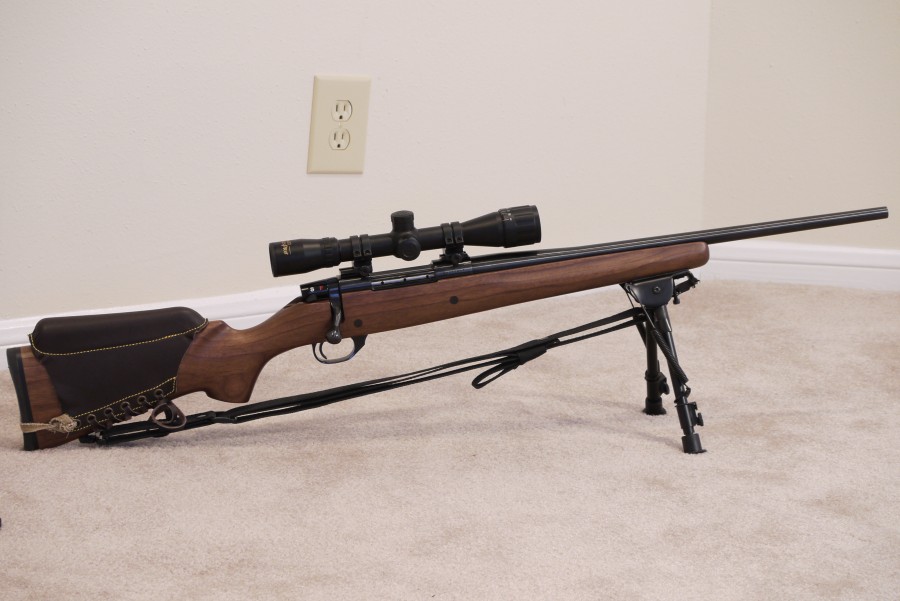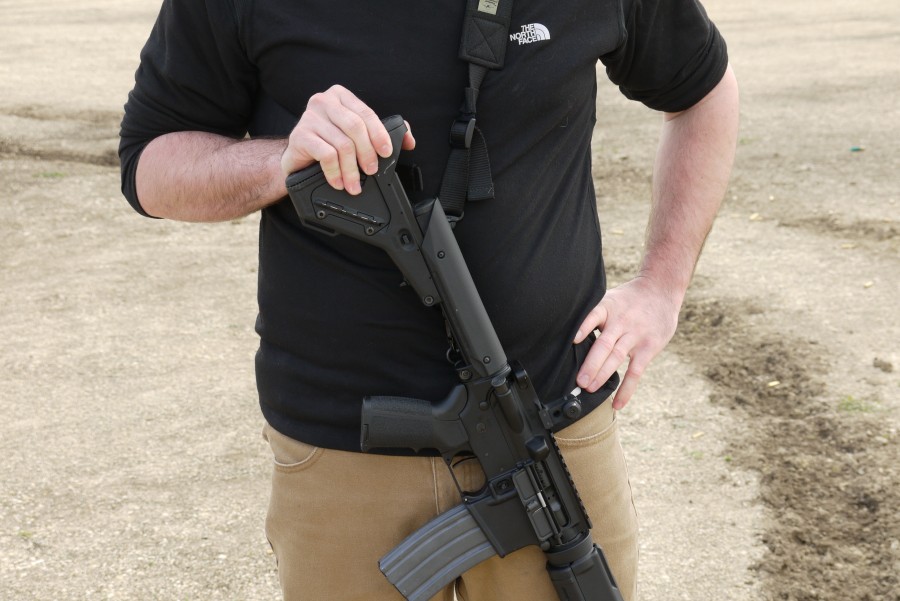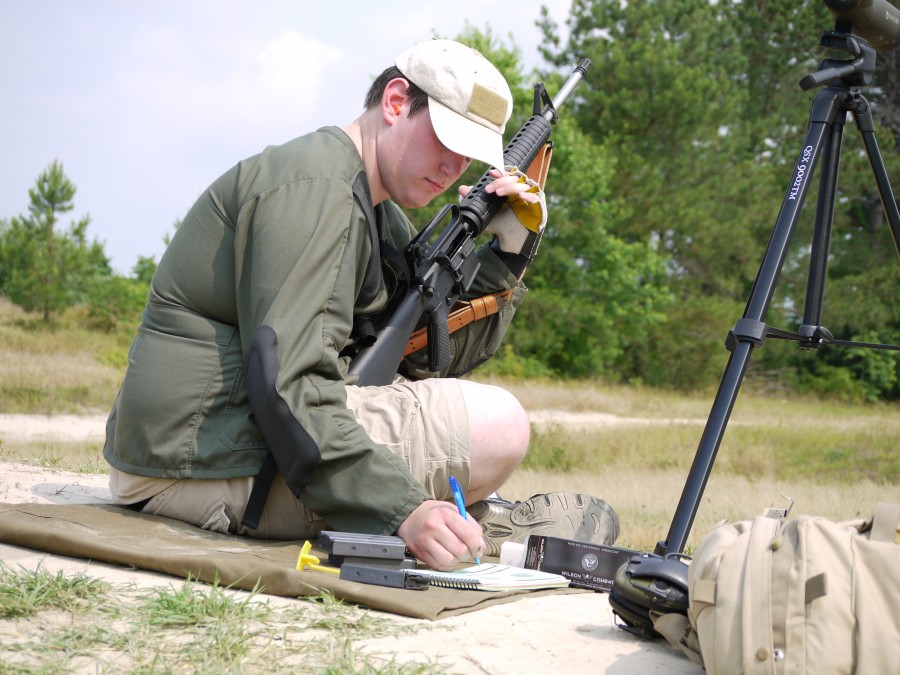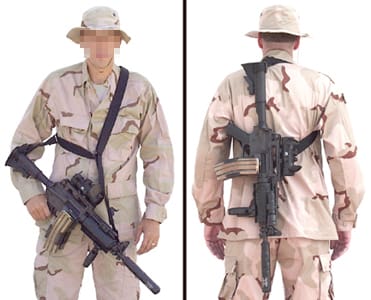Sam asks:
Hello Mr Foghorn, I am Sam Wright on TTAG. I have a nephew who was asking what kind of sling to get for his 2nd hand Mossberg short barreled pump shotgun. I am no expert on slings, so I thought I would as someone who would give me the straight scoop. 2 point, 3 point? Leather, canvas, nylon? Any suggestions or points to be wary of would be appreciated.
Different sling styles are intended for different uses, and work best with different kinds of guns. I’ll get to your specific question in a bit, but I thought this would be the perfect jumping off point to talk about the differences in sling setups. The most common (which we will discuss) are single point slings, two point slings and three point slings (“point” referring to how many places they are attached to the gun).
Single Point Sling
The single point sling attaches to the rifle at only one point, usually somewhere around where the shooter’s trigger hand is gripping the gun. Our man Tyler Kee is shown here rocking a single point sling in a “left hand” configuration on an AR-15 rifle.
The single point sling style isn’t about carrying the gun or distributing the weight of it, instead its entire reason for being is retention. A single point sling is designed with “operators” in mind who either need to keep the enemy from taking their gun or switch quickly to their handgun if their rifle runs dry. You can see a great example of this in the Magpul Dynamic Carbine II videos.
http://www.youtube.com/watch?v=9xoZukUe3xc
The single point sling can also be used to hold your gun while both of your hands are doing something else, but it has a tendency to let the gun dangle and drag in the ground.
In short, the single point sling is for when you’re going to be doing a lot of moving and shooting and need something to keep your gun physically attached to you for short periods of time.
Two Point Sling
The two point sling is the traditional method of carrying a rifle or shotgun, and the majority of the “sporting” firearms you can pick up will be already setup for this kind of sling either using cutouts in the stock or sling swivels (small metal loops). The sling will typically attach at two points, specifically the two points as far forward as possible and as far back as possible along the underside of the firearm. This provides for excellent stability while carrying the gun and will keep it in place through even strenuous activity. Like a 3-gun match.
http://www.youtube.com/watch?v=Jcly8JLm8ks
Not only does the two point sling provide for stable transport of the firearm, but it can also be used ton steady the gun for accurate shooting. The m1907 sling (shown in the picture above on my National Match M-15) was issued universally to the U.S. military from 1907 through the end of WWII because of its ability to be used both to carry the gun and to create a sling to steady the gun for accurate shots. The m1907 was eventually replaced by a nylon web sling when the armed forces realized that jungle fighting didn’t require long distance shooting.
In short, the two point sling is superb for transporting firearms over long distances (say, hiking through the woods while hunting) as well as making precision shots. I’ll have another article shortly on exactly how to use the m1907, so stay tuned.
Three Point Sling
A three point sling is an attempt to combine the comfortable carrying of a firearm you get with a two point sling with the ease of use of a single point sling. The sling consists of a loop of belt that goes around the shooter’s body (draped over one shoulder and under the other) and attaches at two points on the rifle (image from here). Therefore, the front and rear of the rifle plus the shooter’s body compose the three points of contact.
http://www.youtube.com/watch?v=oz6m_rKmCuM
I’m loathe to use a Cheaper Than Dirt video, but the first few seconds pretty well illustrate how the thing works.
Personally, I’m not a big fan of the three point sling due to its somewhat complex design. But it works for a lot of people, and does bridge the gap between the single point and two point slings fairly well making an easy to manipulate and comfortable sling.
So, in summary:
- Single Point: Rapid movement, transitions to handgun, “combat” scenarios.
- Two Point: comfortable carry over distances, accurate shots from a stationary position.
- Three Point: Unholy union of a single and two point, combining some of the features of both.
So which is best for a shotgun?
I’m going to say a two point sling. It makes for an easy to carry solution for your shotgun, and it can be very quickly put on in the middle of the night if you’re responding to a home intruder. It won’t give you the same level of retention as a single point sling, but it’s fairly close. Just keep the sling loop loose for storage, as that will make it easy to put on in a hurry.
[Email your firearms-related questions to “Ask Foghorn” via [email protected]. Click here to browse previous posts]








This is my favorite that I use on most of my long guns. I believe it has many of the features of the m1907.
http://www.outdoorconnection.com/products.cfm?page=details&cat=Sling&sub_cat=Super Sling 2&name=The Original Super Sling 2+
+1 for the Super Sling 2+. Quick to adjust, built tough and inexpensive. Mine’s many years old and still going strong.
2-point slings are usully recommended for shotguns, although my modded 870 wore. 3-point for a few years. The 3-point is versatile and comfy, but it doesn’t transition from left- to right-handed shooting. It also tends to get hung up on buckles or holsters if you’re wearing any other gear.
After I ran a few ‘bump in the night’ drills with the long guns in my safe, I took their slings off because they tended to get fouled on doorknobs and took too long to put on.
Good straightforward review.
I”ve used them all in the conus.
Single Point — Huge pain in ass, except in short-term use only. If you want to see how many mays you can trip over your weapons, how many things you can knock over and catch on your weapon, wear a single-point sling. Wearing a single-point slung weapon is the most reliable way to look like a clumsy gun dork. Be an expert in it, or don’t wear it at all.
Three Point — In tactical scenes, I used to favor the 3-point sling. UNTIL I saw a guy get thrown around like a ninja puppet rag doll by a guy who grabbed his sling and controlled the sling-wearer’s body. Lesson — yes, that harness will keep your gun close. But it is also a set of virtual handles that scream “grab me here” in 360-degree angles of attack. Think you can prevent people from grabbing you in CQB? Good luck with that fantasy. Plus it gets in the way of any other gear you’re carrying on torso or waist. It’s an expert’s sling, and if you don’t use it at least 3 times per week, you will not have the expertise to use it without thinking about it. And if you’re shooting at humans, you do NOT want any gear you have to think about. Even entry team members think twice about carrying this sling style, because they don’t get enough training and re-training time on them.
TWO POINT SLING — Best for most purposes. For hunting/carrying/shooting, it’s the most versatile, PLUS it GETS OUT OF THE WAY when you don’t need it. The other two sling styles do not. Before vietnam, the militaries of WWII had highly trained, highly effective commando and special ops units. They relied on the two-point sling, which until the 80s was just called “a sling,” and they used it very effectively in CQB and all other forms of armed combat. Think you can’t employ your weapon fast with a 2-point sling? Wrong. Carry it in standard marching position, over your strong shoulder, muzzle up. Use your strong hand to to reach back and underneath, grab the stock, and pull the stock forward, flipping the weapon where the muzzle rotates backwards and underneath. I’ve seen it done was fast as a guy can draw from a military M-9 secured holster. And that’s just the basics.
I 100% agree with the koolaidguzzler here.
Rocking the one-point or three-point sling is the quickest way to achieve TacticDouche status, and for 98% of folks out there, the two-point will work fine.
Well said. I’ve used the two point sling “under muzzle flip” in the Marine Corps, and while deer hunting to quickly present the weapon. It works very well with my Remington 700 LTR .308 and Browning X-cellerator sling. Just be sure no one is directly behind you so you won’t laser them with your muzzle.
I learned it in the Army with M16s, when ODs were still the norm. I later used the move with 18″ pump guns. A little more awkward with the 870s, due to weight distribution.
My Dad who was a Korean War vet taught me to carry a rifle slung muzzle down, butt up over the weak shoulder. Grasp forend with weak hand rotating muzzle forward and up and sling dropping to elbow rotate stock to strong shoulder and keep sling in “hasty” position around weak elbow. Sling now offers “triangulation” support for offhand shooting and you didn’t have to muzzle sweep those behind you. Main downside was muzzle in dirt if you had to drop down.. solution was to bring rifle to low ready if dropping.
Thanks for the explanation. I will forward this link to my nephew and hopefully make a new TTAG reader out of him.
Sam, that was an excellent question, and Nick gave us an excellent answer, and I learned some good stuff from this, so I thank you both!!
I prefer 2 point slings, quick adjust ones if possible. They allow you to go hands off with the rifle or help support it’s weight while on patrol or guard or something. In my opinion 2 points are preferable to 1 points for sidearm transitions because the 1 points dangle the gun in front of you, impeding your movement and knocking you in your knees and nuts. You can use the quick adjust 2 points like the VTAC/Vickers style to stay in the sling while transitioning or you can use the spetsnaz transition to quickly and easily sling the rifle along your back.
+10
The VTAC/Vickers sling is EXCELLENT. Moderate price, excellent construction, great utility.
TAG makes a budget version that I highly recomend. I own four of the VTAC slings (Three ARs, one shotgun) and two of the TAG slings (Both on .22’s.)
http://www.tacticalassaultgearstore.com/adjustable2pointsling.aspx
Also the 2pt sling is the fastest to don/doff. The 1 and 3pt slings take a moment to put on. If that is your “bump in the night” shotgun, use a 2pt.
If you’re considering using a shotgun, AND if your use criteria are:
1. Inside home only;
2. In the dark;
3. Awakened in bed;
…..then use a handgun with a rail-attached light. Or with hand held light.
Reasons: there are so many scenarios where you will need a free hand to steady yourself or orient on walls and doorframes, to open close doors, light switches, to push, pull, fend off thrown objects or personal struggle, to retain weapon, to shield your eyes when light is directed into your face. Long guns have three disadvantages: in close quarters, they hit and bump and hangup on walls, doorways, furniture, etc:, they require two hands; you can’t easily tuck a shotgun inside your arm reach while shooting; in CQB your shotgun muzzle are more easily controlled and moved off-target by opponents than handguns. It’s easier for an opponent to wrestle with your shotgun than your pistol. If you believe you can keep all invaders in your home at least 10 ft away from you at all times, then you’re a better and luckier tactician than 99% of the shooters here.
Thats wrong. I’ve said it before, and i’ll say it again, long gun retention is many, many times easier than handgun retention. You have leverage to your advantage, and a buttstock to smash with.
Some one moves that barrel, they’re bringing the buttstock closer to their face and head.
Agree with the view that a (not-so-long) long gun isn’t difficult to handle indoors and is easier to retain. Agree with the light on a house gun. Also think a two point sling is the way to go if that is what you use when hunting. Multiple sling styles seems like asking for trouble for civilian defensive use. The advantage of a pistol grip on a defensive long gun stock is exactly that one hand can be freed without difficulty and aids retention: One handed control is simple and if the perp is there, you put the free hand back on the long gun very fast, no? One-point: Nice for rifles or carbines, but the techniques are so different from two-point I would hesitate to use one. We didn’t have them in ’71. Laugh.
Dave, you’re trained in long gun CQB, aren’t you? That already puts you in the unrepresentative minority of home defenders. Second, many home interiors, like hallways, bathrooms, alcoves, stairways, etc, only facilitate strokes on the vertical plane, not the horizontal. I’m addressing the average joe, not combat-trained longgun carriers. Have you seen the average joe in long gun CQB? Everyone’s a gunfighter in their mind until the fight is in their face. You’re trained and presumably experienced. Your abilities should not be the standard by which joe-schmoe should formulate his home defense tactics.
I know many people who swear by the three point sling but I find it to be too difficult to adjust and I feel like I’m trussed up by spiderman.
I prefer the single point sling. I’ve never seen a single point sling attached so far to the rear. Usually I see the sling attached at the point just forward of the stock.
As for the two point sling and carrying it muzzle up, that’s not allowed in the USMC anymore. Makes no sense to me, but they didn’t ask me when making that rule.
Thanks for reminding me that when I made my above comments, I directed them to non-military shooters. There are many methods in how the military uses gear that are not appropriate for non-military environs.
thanks to dr. dave and pascal for the 2-point sling product tips.
A lot of misconceptions are out there about slings.
A single point sling is acutally really, really handy, and I dont know where the fark people are getting the idea that they’re difficult to put on. I could put one on upside down in the dark while getting bit by spiders.
Guess why?
I TRAIN with my gear. Every day.
That includes holsters, firearms, flashlights, load bearing gear, and, you guessed it, slings.
The best sling in the world, just like the best gun in the world, is about useless if you don’t know how to use it right.
Three point slings: Great for real heavy weapons. When I carried an M249 SAW in the USMC, I had a three point sling on that beast. Weighing 17 pounds unloaded, standing around with it all day, much less taking it on patrol, takes some effort. A good sling that lets your shoulders take some of the weight helps with that.
On a medium sized rifle, like the M16 I was also issued, a two point sling is a great compromise: It allowed me to still carry a fairly heavy (Ten or so pounds) rifle long distance, and still be able to strap it to my body so I could use both hands.
The most important part of using a two or three point sling is having the sling mount to the SIDE and not the bottom of the rifle: That allows you to hang it off your torso in a way that makes it easier to swing the long gun onto target.
On lighter weapons, like SMGs or carbines, a single point sling is lovely. You get great freedom of movement, and although it dosent really help you haul it around, you can still drop the rifle with out it hitting the deck, if you understand what I mean. A single point is also probably the least complex, easiest to don/remove sling system out there. You put it on kinda like a shirt: Put it over your neck, and thread an arm through it, and you’re ready. Because its basically just a simple U shaped loop of nylon, they’re easy to use. They are, however, very, very uncomfortable with weapons over eight or nine pounds, and if you have a longer than 16” barrel, its real easy to knock it into things.
That being said, however, if you’re carrying a long gun, your hand should be on the pistol grip, period, no exceptions. A weapons is worthless if you cant get it into the fight quickly.
Slings are nice because it allows you to use both hands, and still retain quick access to your weapon.
A good, rough guide line is that when you have the firearm slung in front of you, the butt stock should be right around your sternum/heart, muzzle down. Any higher, and you have to fumble to get the stock into the pocket. Any lower, and your muzzle is going to be knocking against your pelvis or knees, even, and you’ll have excessive waste movement bringing it up.
I had a 3-point side mounted on my M-16A2 (yes, go ahead and laugh) in Afghanistan. A good one is a joy to use, and you don’t even think about it, although it must be settled carefully around your other gear. A bad one just sucks, and you’ll always be fighting it. I lucked out and picked a good one right off the bat, though I’ve long since forgotten the brand. But I was carrying it all day every day for a year and almost never had to use it.
People are gona hate.
But proffesonials still use three point slings, and will, until something way better comes around. Because they work well in certain circumstances.
Three points suck for lefty shooters. That third strap creates a perfect obstruction in front of the ejection path for empties to bounce back into the open action of a cycling firearm don’t bother asking how I know…haha!
Foghorn does it again.
I’ve tried inquiring about slings at gun shows on a couple occasions in the past, but I was never successful in extracting any useful information from the tacticool wharrgarbl.
Thanks for the writeup.
Apparently I have a gift.
Glad to help. Let me know if you have any other questions!
I use 2 point, but I am not Tacticool. I just use the slings to tote the iron over hill and dale hunting fluffy bunny or cute groundhog.
Same here, for 98 1/2 % of the time. I have used the 2 point sling wrapped around my off arm to steady the rifle when shooting longish distances with good results, but it’s been years since I have done that.
Comments are closed.